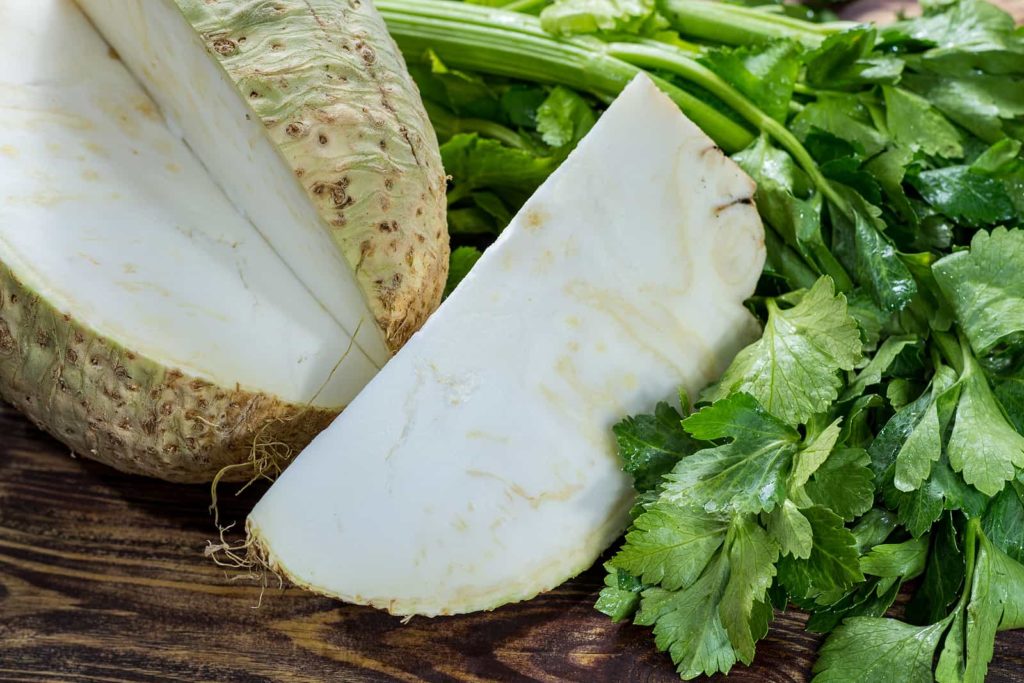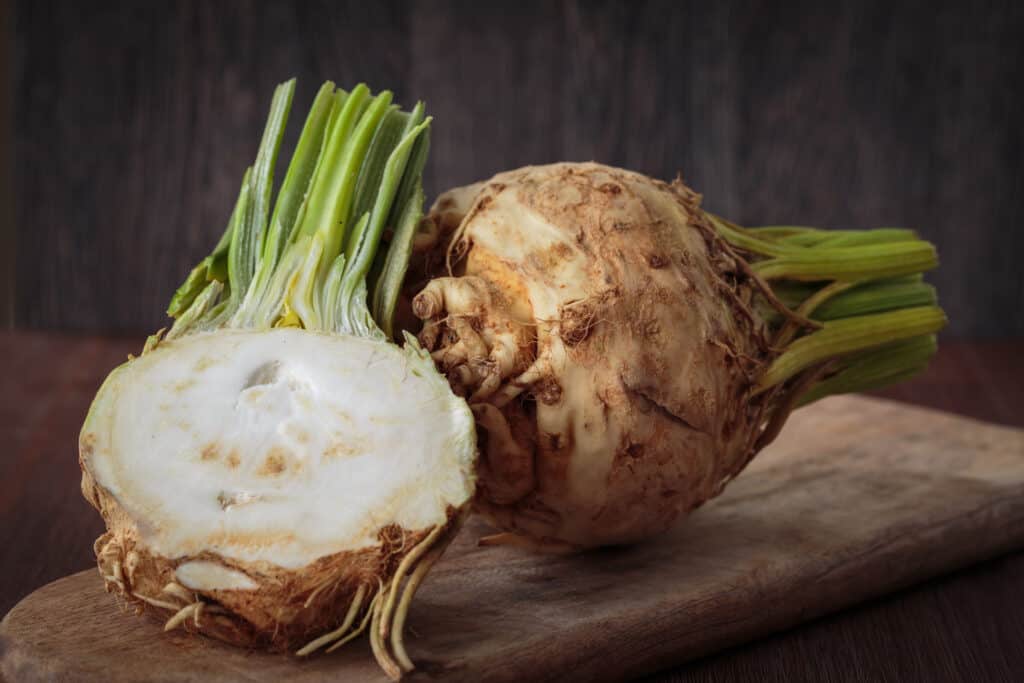Celeriac is a cool-season biennial grown as an annual. It has similar requirements as celery.
Celeriac is also known as celery root. Celeriac is grown for its large, swollen root that looks something like a turnip. The root develops at the soil level similar to a turnip but celeriac is a member of the celery family and has a similar growth habit. From the root, a rosette of dark green leaves sprouts atop hollow stems.
Celeriac is best started indoors and later transplanted into the garden. Celeriac is best when it comes to harvest in cool weather. Like celery, celeriac seedlings are likely to bolt if exposed to low temperatures in the 30s and 40sF for more than a week or two. Set seedlings in the garden after the last frost.
Sow celeriac seed indoors as early as 8 weeks before the average last frost date in spring. Celeriac requires 90 to 120 days to reach harvest.
Related articles:
- Five Ways to Cook and Serve Celeriac
- Tasty Ways to Cook and Serve Celery
- Celery Seed Starting Tips
- How to Plant and Grow Celery
- How to Harvest and Store Celery
- Celery Growing Problems Troubleshooting

Celery planting details
- Sowing depth: 1/2 inch (12mm) or less
- Space between plant after thinning: 6-8 inches (cm)
- Days to sprout: 21; pre-sprout by placing seeds in a damp paper towel at room temperature for a few days
- Days to harvest: 100
- Storage period: 6 months
- Seeds per 100-row feet: ½ ounce
- Yield per 100-row feet: 200 plants
Yield. Grow 2 to 3 celeriac plants per household member.
Tools for Vegetable Gardeners at Amazon:
- A.M. Leonard Straight Rake with Ash Handle
- All-Steel Nursery Spade with D-Grip Handle
- 4-Tine Spading Digging Fork with D-Handle
- Digital Soil pH Meter Outdoors Greenhouse
- Earthwise Handheld Electric Fertilizer Spreader

Where to plant celeriac
Celeriac grows best in full sun but will tolerate light shade. Plant celeriac in moisture-retentive but well-drained soil rich in organic matter. Add aged compost to planting beds before plants and again at midseason. Celeriac is a heavy feeder; give plants a side dressing of compost tea every 2 to 3 weeks during the growing season.
Celeriac planting time
Celeriac grows best in cool weather, especially when nights are cool. Grow celeriac in spring in cold-winter regions; in warm-winter regions grow celeriac beginning in late summer so that it matures in cool weather. Celeriac is slow to germinate and is best grown from transplants. Sow seed indoors as early as 10 weeks before the average last frost date in spring. Plants can go into the garden on the average date of the last frost. Celeriac requires up to 120 days to reach harvest. A late summer crop can be sown directly in the garden where there is enough time for a second harvest.
Celery seed starting dates
(These dates are for the Northern Hemisphere)
| Average date of the last frost | Planting dates |
| Jan. 30 | Jan. 1-Feb. 1 |
| Feb. 8 | Jan. 10-Feb. 10 |
| Feb. 18 | Jan. 20-Feb. 20 |
| Feb. 28 | Feb. 1-Mar. 1 |
| Mar. 10 | Feb. 20-Mar. 20 |
| Mar. 20 | Mar. 1-Apr. 1 |
| Mar. 30 | Mar. 15-Apr. 15 |
| Apr. 10 | Apr. 1-Apr. 20 |
| Apr. 20 | Apr. 10-May 1 |
| Apr. 30 | Apr. 15-May 1 |
| May 10 | Apr. 20-June 15 |
| May 20 | May 10-June 15 |
| May 30 | May 20 -June 1 |
| June 10 | June 1-June 15 |

Celeriac planting and spacing
Sow celeriac seed ⅛ inch deep. Place a seed cloth or burlap over the seeding area to keep the soil moist until plants sprout.
Celeriac seed can be slow to germinate. Fold seeds into a damp paper towel and place in a plastic bag for a few days at room temperature until they sprout then transplant them to a flat with moistened seed mix. Grow the seedlings at room temperature.
When plants are 3 to 4 inches (7.6-10cm) tall thin them from 6 to 8 inches (15-20cm) apart or transplant them into the garden at that distance.
Space rows 24 to 30 inches (61-76cm) apart. Celeriac is often set into the garden in 3- to 4-inch (7.6-10cm) deep trenches, similar to celery. As the plants grow, soil can be mounded around the exposed root.
Celeriac companion plants
Grow celeriac with lettuce, spinach, and garden peas. Do not plant celeriac with pumpkins, cucumbers, or squash.
Container growing celeriac
Celeriac can be grown in a container, but not well. Choose an 8-inch (20cm) container for a single plant.

Watering and feeding celeriac
Water regularly when growing celeriac; keep the soil evenly moist or the roots will dry out and become tough.
Celeriac is shallow-rooted and requires regular watering. Lack of soil moisture will cause celeriac to stop growing. Keep the top few inches of soil moist at all times.
Celeriac care
Keep celeriac planting beds weed-free to avoid competition for water and nutrients. Cultivate carefully to avoid celeriac’s shallow roots. As the root develops, snip off the side roots and hill up the soil over the swollen bulbous root to blanch it. The outside of the root will blanch white but the flesh will remain a brownish color.
Celeriac pests and diseases
- Celeriac has no serious pest problems.
- Celeriac has no serious disease problems.

Harvesting celeriac
Harvest celeriac when the swollen root is 3 to 4 inches (7.6-10cm) across or slightly larger. Cut stems close to the knobby root; use a garden fork to lift the roots. Celeriac will increase with flavor following a light frost but should be harvested before the first hard freeze. From seed, celeriac will reach harvest in 110 to 120 days.
Storing and preserving celeriac
Celeriac will keep in the refrigerator for up to one week, or store the root in a cold, moist place for 2 to 3 months. Celeriac will keep in the ground where the soil does not freeze. Leaves can be used as an herb in soups and stews.
Celeriac kitchen use
Celeriac roots can be braised and blanched until just tender-crisp; they can also be boiled and mashed. Raw celeriac root can be grated for salads. The leaves and stalks are strong, bitter-flavored, and tough, basically inedible.
Celeriac leaves can be used to flavor soups and stews.
Celeriac at Harvest to Table:
How to Plant, Grow, and Harvest Celeriac
Five Ways to Cook and Serve Celeriac
How to Harvest and Store Celery
Tasty Ways to Cook and Serve Celery
Celery Growing Problems Troubleshooting
Celeriac varieties to grow
Varieties: ‘Alabaster’ (120 days); ‘Giant Prague’ (120 days); ‘Brilliant’; ‘Large Smooth Prague’; ‘Jose’.
About celeriac
- Common name. Celeriac, turnip-rooted celery, celery root, knob celery
- Botanical name. Apium graveolens rapaceum
- Origin. Europe and Africa
Related articles:
Learn how to plant, grow, and harvest your favorite vegetables. Click below for all you need to know.
- Artichoke
- Arugula
- Asparagus
- Beans, Snap
- Beets
- Broad Beans
- Broccoli
- Brussels Sprouts
- Cabbage
- Cantaloupe — Melons
- Cardoon
- Carrots
- Cauliflower
- Celeriac
- Celery
- Chard
- Chayote Squash
- Chickpeas
- Chicory
- Chinese Cabbage
- Collards
- Corn Salad
- Corn, Sweet
- Cresses
- Cucumbers
- Eggplant
- Endive and Escarole
- Fava Beans
- Florence Fennel
- Garbanzo Beans
- Garlic
- Horseradish
- Jerusalem Artichoke
- Kale
- Kohlrabi
- Leeks
- Lettuce
- Lima Beans
- Melons
- Mizuna
- Mustard Greens
- New Zealand Spinach
- Okra
- Onions
- Parsnips
- Peanuts
- Peas
- Peppers
- Potatoes
- Pumpkins
- Radicchio
- Radishes
- Rhubarb
- Rutabaga
- Salsify
- Shallots
- Sorrel
- Southern Peas
- Soybeans
- Spinach
- Squash, Summer
- Squash, Winter
- Sunchokes
- Sweet Potato
- Swiss Chard
- Taro
- Tomatillo
- Tomatoes
- Turnips
- Watermelon
- Zucchini
How to Plant, Grow, and Harvest Celery
Garden Planning Books at Amazon:
- Vegetable Garden Grower’s Guide
- Tomato Grower’s Answer Book
- Vegetable Garden Almanac & Planner
- Kitchen Garden Grower’s Guide Vegetable Encyclopedia
Grow 80 vegetables: THE KITCHEN GARDEN GROWERS’ GUIDE



